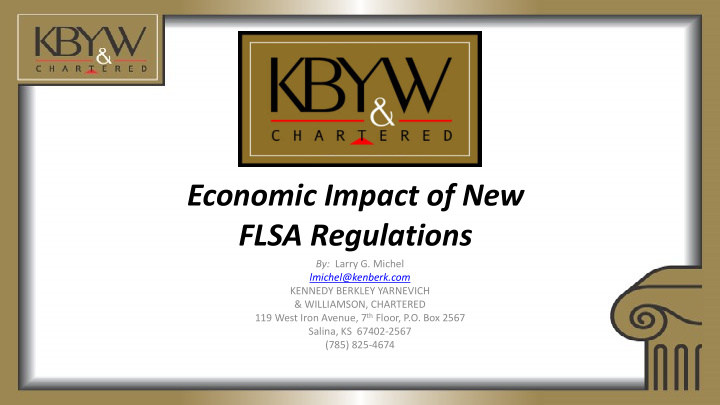



Economic Impact of New FLSA Regulations By: Larry G. Michel lmichel@kenberk.com KENNEDY BERKLEY YARNEVICH & WILLIAMSON, CHARTERED 119 West Iron Avenue, 7 th Floor, P.O. Box 2567 Salina, KS 67402-2567 (785) 825-4674
Wage and Hour Law New Regulations governing white collar exemptions Effective December 1, 2016
Proposed Regulations Published July 6, 2015 Directed by President Obama Not updated since 2004 Current salary threshold below poverty limit for family of 4
Minimum Wage and Overtime Regulated by the Fair Labors Standard Act (“FLSA”) – 29 U.S.C. § § 201, et seq. Covers more than 130 million American workers
Coverage Enterprise coverage: Must have at leave two employees and meet one of the following two requirements: • Business volume of at least $500,000.00 or • Be a hospital, school, government agency or other such entity
Coverage Individual coverage: Engage in interstate commerce; or • Domestic service workers •
Coverage Individual coverage if engaged in interstate commerce or production of goods interstate phone calls shipping materials Isolated occasions or insubstantial amount of time will not usually result in claim
Coverage Volunteers generally exempt unless commercial activity (i.e., gift shop) Employee may not volunteer to do same type of services as they are employed to provide
Minimum Wage All covered employees must be paid minimum wage for all hours worked – $7.25 per hour since July 24, 2009
Overtime Pay Requirements Unless exempt an employee must generally receive overtime pay for hours worked in excess of 40 in a given work week Overtime calculated at one and one-half times the regular rate of pay
Overtime Pay Requirements No limit on number of hours an employee may work Employer is not required to pay overtime for work on Saturday, Sundays or Holidays so long as total hours in work week do not exceed 40
White Collar Exceptions to Overtime 1. Executive exemption; 2. Administrative exemption; 3. Professional exemption, including learned professionals and creative professionals; 4. Computer employee exemption; 5. Outside sales exemption; and 6. Highly compensated employees
Salary Basis Current At least $455 per week Predetermined amount each pay period Cannot be reduced due to quality or quantity of work Limited reasons for deductions
Salary Basis Effective December 1, 2016 Salary must be at least $913 per week or $47,476 per year. Updated every 3 years. 40% Percentile of full-time salaried workers.
Economic Impact on Employers Department of Labor Analysis Direct Costs Transfers Deadweight Loss
Direct Cost to Employers DOL: Estimates $295.1 Million per Year Regulatory Familiarization Adjustment Costs Managerial Costs
Transfers Income from Employers to Employees in the Form of Higher Earnings $1.19 Billion per year
Deadweight Loss $9.2 Million per year Small in Comparison to Total Costs
Next Steps for Employers Are they covered? 40 hour employees at $913 per week equivalent to approximately $22.83 per hour Switch to hourly pay? No Overtime?
Questions?
Thank you!
Recommend
More recommend